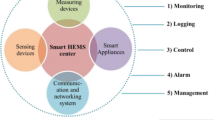Abstract
This paper presents an innovative method to synchronize physical clocks for a computational grid, in particular for a computational grid linked through the asynchronous Intranet or Internet environments. The method discussed is an asynchronous self-adaptive clock synchronization mechanism. Two strategies for clock synchronisationare introduced. (1), Use continuous time intervals to calculate the precision of clocks, which can reduce the effect of network delay efficiently. (2) Every node synchronizes its clock, with its leader actively. In addition, a node self-adaptive model is presented, and the relationship between the clock precision and synchronization time is induced, hence a node can predict when it should begin the synchronization process. Detailed simulation and extension of this issue are provided at the end of the paper. The presented model is both practical and feasible.
Similar content being viewed by others
References
Tierney B, Crowley Bet al. A monitoring sensor management system for grid environments.Cluster Computing, March, 2001, 4(1): 19–28.
Liskov B. Practical uses of synchronized clocks in distributed systems.Distributed Computing, 1993, 6: 211–219.
Cristian F. Synchronous and asynchronous group communication.Comm. ACM, April 1996, 39(4): 88–97.
Sinha P K. Distributed Operating Systems. John Wiley & Sons, 1997, pp. 286–300.
Mock Met al. Continuous clock synchronization in wireless real-time applications. Inthe 19th IEEE Symp. Reliable Distributed Systems, 2000, pp. 125–132.
Lamport L, Melliar-Smith P. Synchronizing clocks in the presence of faults.J ACM, January 1985, 32(1): 52–78.
Srikanth T K, Toueg S. Optimal clock synchronization.Journal of the ACM, July 1987, 34(3): 626–645.
Butler R W. A Survey of Provably Correct Fault-Tolerant Clock Synchronization Techniques. NASA Technical Memorandum 100553, Langley Research Centre, February 1988.
Azevedo M Met al. Multistep interactive convergence: An efficient approach to the fault-tolerant clock synchronization of large multicomputers.IEEE Trans. Parallel and Distributed System, Dec. 1998, 9(12): 1195–1212.
Mills D L. Internet time synchronization: The network time protocol.IEEE Trans. Communication, October 1991, 39(19): 1482–1493.
Nonaka J, Pfitscher G Het al. An evaluation of low cost hardware assisted internal clock synchronization in PC cluster environment. InThe 2002 Int. Conf. Parallel and Distributed Processing Techniques and Applications, Las Vegas, USA, June 24–27, 2002, pp. 456–461.
Bouzelat A, Mammeri Z. Simple reading, implicit rejection and average function for fault-tolerant physical clock synchronization. InThe 23rd EUROMICRO Conference'97 New Frontiers of Information Technology, 1997, pp. 524–530.
Cristian F. Reaching agreement on processor-group membership in synchronous distributed system.Distributed Computing, 1991, 4: 175–187.
Fetzer C, Cristian F. A highly available local leader election service.IEEE Trans. Software Engineering, September/October 1999, 25(5): 603–618.
Ryu M, Park J, Hong S. Timing constraint remapping to avoid time discontinuities in distributed real-time system. InThe Fifth IEEE Real-Time Technology and Applications Symposium, June 2–4, 1999, pp. 89–98.
Author information
Authors and Affiliations
Corresponding author
Additional information
This research is supported by the 2001 Distinguished Visiting Scholar Program sponsored by the Chinese Government.
ZHAO Ying is an associate professor and vicedirector of International Network Center, Beijing University of Chemical Technology. He graduated from the Department of Computer Science and Engineering at Tianjin University in 1987. He obtained his M.Eng. from Beijing University of Chemical Technology in 1996. In 2002, as a senior visiting scholar, he visited Deakin, University for one year. His primary research interests are computer networks, distributed operating system, and grid computing.
ZHOU WanLei is a professor, head of School of Information Techynology, Deakin University, Australia. He received his B.Eng. and M.Eng. degrees from Harbin Institute of Technology in 1982 and 1984, respectively, and his Ph.D. degree from the Australian National University in 1991. His research interests include theory and practical issues of building distributed systems, Internet computing, distributed and heterogeneous databases, mobile computing, performance evaluation, and fault-tolerant computing. Dr. Zhou is a member of the IEEE and IEEE Computer Society.
HUANG JiuMei is a senior engineer of International Network Center, Beijing University of Chemical Technology. She graduated from the Department of Automation and obtained her B.Eng. at Beijing University of Chemical Technology in 1988. Her research interests include computer networks, and e-learning.
YU Shui received his B.Eng. and M.Eng. degrees from University of Electronic Science and Technology of China in 1993 and 1999, respectively, and now he is a Ph.D. candidate in School of Information Technology, Deakin University. His research interests include distributed systems, anycast, multicast, mobile comuting, distributed and heterogeneous databases, and performance evaluation.
Elicia J. Lanham received her B.Comp. and B.Comp. (Honours) from Deakin, University, Australia in 2000 and 2001 respectively. She is currently a Ph.D. candidate in the School of Information Technology at Deakin University, Australia. Her research interests include e-learning and Quality of Service.
Rights and permissions
About this article
Cite this article
Zhao, Y., Zhou, W., Huang, J. et al. Self-adaptive clock synchronization for computational grid. J. Comput. Sci. & Technol. 18, 434–441 (2003). https://doi.org/10.1007/BF02948917
Received:
Revised:
Issue Date:
DOI: https://doi.org/10.1007/BF02948917




